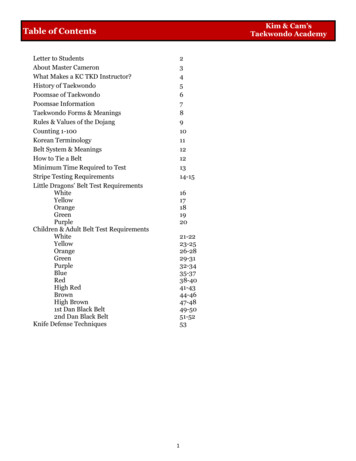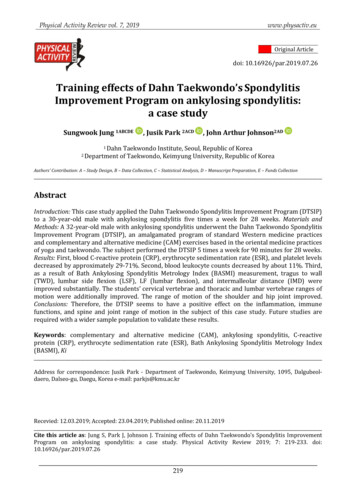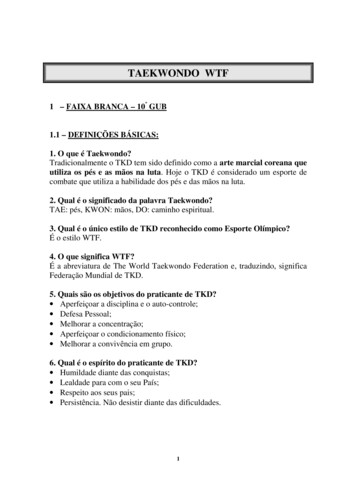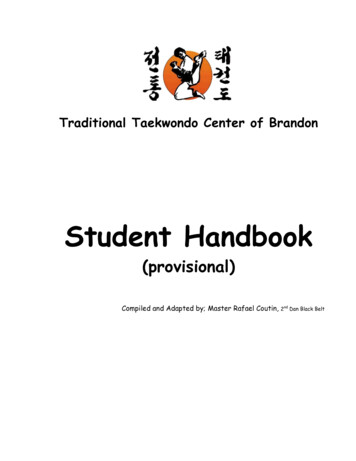
Transcription
Nothing is so strong as gentleness. Nothing is so gentle as real strength.studenthandbook터커 태 권 도
Table of ContentsTHE ART OF TAE KWON DO: ADVENTURE IN SELF-DISCOVERYTHE AIM OF TAEKWONDO: BODY, MIND & SPIRIT WORKING AS ONEMARTIAL ARTS “MAGIC”: THE LONG ROAD TO HONEST ACHIEVEMENTTAEKWONDO AND TRADITION: THE PROUD HERITAGE OF THE HWARANG DOBELT STRUCTURE AND PROMOTIONSTUCKER TAEKWONDO CENTER TRAINING SESSIONSSAFETYBEFORE CLASSATTENDANCE CARDSOPENING CLASSBASIC TECHNIQUES (KI CHO)FORMS (POOM SE)SPARRINGSELF-DEFENSEMEDITATIONMEDITATION TECHNIQUESCLOSING CLASSGENERAL RULES FOR CLASS AND DOJANGUSE OF TAEKWONDO OUTSIDE THE DOJANGTERMINOLOGYONE STEP SPARRING23345666778891011111113151621
Tucker Taekwondo Center ( TTC ) is located at 3781 Presidential Pkwy, Suite 138, Tucker,GA . The school was founded in 2008 by Master Wallace Taylor in response to a growingdemand in the area for top quality Taekwondo instruction.The purpose of this Student Handbook is to welcome you to the school ; outlinethe rules, guidelines and expectations of our school; and provide you with an initialintroduction and guide to the wonderful, life-altering journey you are about to undertake.This handbook is in no way inclusive of all the writings that are available related toTaekwondo and the martial arts. Students are encouraged to obtain and read all they canto learn more about our art.January 20101
THE ART OF TAE KWON DO : ADVENTURE IN SELF-DISCOVERYTaekwondo is a traditional Korean martial art, which translated literally means: “the artof hand and foot fighting”. It combines sharp, strong angular movements with graceful and freeflowing circular motions to produce a harmonious marriage of beauty and power. With theaddition of its own devastating kicking techniques, Taekwondo is a complete, integrated, andunique system of self-defense and personal improvement.태 Tae Jumping, Kicking with the foot권 Kwon Punching, Smashing with the fist도 DoThe WayTaekwondo is a method of self-defense without weapons. Flesh and bone, the natural,vulnerable equipment of the body, are the only resources of the Taekwondo practitioner.Therefore, the techniques of Taekwondo are designed to train all the muscles and joints of thebody to develop their ultimate capacities toward an integrated and totally efficient mechanism fordefense. More importantly, Taekwondo is a state of mind. Control of one’s mind, self-restraint,kindness, and humility must accompany physical grace.Taekwondo develops in a person the speed and power to kill instantly with his or her bare handsand feet. But it is the discipline and mental aspect of Taekwondo that allow one to develop thecontrol, coordination and balance, so that punching and kicking movements can be stopped justcentimeters short of their mark. By combining the two equally important aspects of Taekwondo,you will gain confidence and a feeling of well being in a non-aggressive, non-violent manner.It is no wonder that Taekwondo is the fastest-growing martial art in the world today, itsappeal is universal. As a practical means of self-defense, a satisfying and complete regimen ofphysical conditioning, an aid to improved concentration and mental performance, and anOlympic Sport, the art of Taekwondo offers its riches to anyone who sincerely undertakes itsstudy. Within the dojang, there are no ages, sex, religious, cultural or racial barriers; all beginequally as white belts. Under the watchful eye of the Master Instructor, each progresses at his orher own rate, according to individual effort and ability.January 20102
THE AIM OF TAEKWONDO :BODY, MIND & SPIRIT WORKING AS ONETaekwondo training addresses the whole individual body, mind, and spirit and involves a greatdeal more than mere physical technique. To be sure, the student of Taekwondo is expected todevelop strength, stamina, quickness, flexibility, coordination, and balance. Along with a varietyof effective hand and foot self-defense techniques, these physical skills are fundamental to theart, and can be perfected only through dedication and tireless practice. However, the road totrue mastery also requires that formidable physical accomplishments be balanced with theequally important mental characteristics of patience, humility, self-control, perseverance,concentration and respect. These too must be practiced faithfully, both in and out of class.Gradually, the lessons of the dojang begin to color other aspects of life. Mind, body and spiritbecome unified and transformed, and living becomes richer and more enjoyable.The study of Taekwondo can improve you as a person. It will teach you to control your ownidentity, aggression, temper, and insecurity. It can make you extremely sensitive to yourenvironment so that you cannot be taken unaware, and will help you to truly know yourself sothat you will be in full command of your own strengths and weaknesses and able to perceive thestrengths and weaknesses of your opponent as well as those inherent in any situation.MARTIAL ARTS “MAGIC” :THE LONG ROAD TO HONEST ACHIEVEMENT“How long will it take?” This is the question we all ask when starting out. “How long to attain ablack belt?”, “How long before I can do those fancy spinning kicks?” The only possible answer tosuch questions is that it takes as long as it takes. There are no magic shortcuts, no secrettechniques, and no mystical practices that will instantly transform a person into a martial artist.Public attention tends to focus on the flashy aspects of the martial arts—the dramatic kickingand breaking techniques, and flashy demonstrations. In actual fact, training consists of very little“flash”, and a great deal of hard work constant, dedicated practice and tireless physicalconditioning. With proper instruction and sufficient perseverance, anyone can attain his or her fullpotential in the art of Taekwondo, achieving that level of skill which, to the uninformed, appearsto be “magic”.January 20103
It usually requires at least several years of serious study and practice to reach black belt level.Gaining in skill, the student’s advancement is marked by the award of a colored belt, whichsignifies class rank. Hard won, each new belt of promotion can be worn proudly as a symbol ofhonest accomplishment—but of course, it remains only a symbol.The truly successful student is the one who has learned to enjoy walking the path, ratherthan worrying too much about the destination.TAEKWONDO AND TRADITION : THE PROUD HERITAGE OF THE HWARANG DOAlthough the name “Taekwondo” was developed in modern times, the origins of the art reach farback into Korean history. During the sixth century A.D., the Korean peninsula was divided intothree kingdoms: Silla, Baek Je, and Koguryo. Silla, the smallest, was in constant peril of beingoverrun by her more powerful neighbors, and in response to this pressure assembled an elitefighting corps chosen from among the aristocracy, known as the Hwarang Do or “Flower Youth”.In addition to the regular military training of the day, the Hwarang Do subjected themselves torigorous mental discipline and severe physical hardship in order to condition the body and will togreat strength and long endurance. Legend has it that they went into the mountains and alongthe seashore, studying the fighting styles of wild animals, and adapting the techniques of natureto their own advantage. New movements were added to the existing form of weaponless fightingknown as Tae Kyon, popular among the common people. In addition to these new hand and foottechniques, the Hwarang also incorporated into their art certain Buddhist exercises in intenseconcentration, in order to achieve a harmonious integration of mind and body.Modern Taekwondo owes much to the valorous Hwarang Do. The ethical spirit traces directly tothe five-pointed code of conduct of the Hwarang, which emphasized the virtues of fidelity,courage, patriotism, obedience to lawful authority and a deep and abiding respect for all life. Toconsider Taekwondo as simply a sport, or just another means to get in shape, is to deny theproud heritage of almost 2,000 years. The combined thought and experience of centuries hasproduced our modern art, which continues to draw strength and stability from the past.January 20104
BELT STRUCTURE AND PROMOTIONSWhite10th GupSIP-KUBYellow9thGupGU-KUBYellow Stripe8th GupPAL-KUBGreen7th GupCHIL-KUBGreen Stripe6thGupYUK-KUBBlue5thGupO-KUBBlue Stripe4thGupSA-KUBBrown3rdGupSAM-KUBBrown Stripe2nd GupE-KUBRed1stGupIL-KUBDegreeIl DHAN2nd DegreeE DHANRed StripeBlack Belt1st3rdDegreeSAM DHAN4thDegreeSA DHAN5thDegreeOH DHAN6thDegreeYUK DHAN7thDegreeCHIL DHAN8thDegreePAL DHAN9thDegreeGUDHANPromotional tests are held approximately every two (2) months. On promotion test days, thereare no regularly scheduled classes. Students are eligible to test if the following criteria are met: Student is invited to test by Master InstructorStudent is in good standing with schoolStudent tuition is paid up to dateStudent has been attending class regularly (at least 1.5 times per week)January 20105
Important things to remember on test day: Give your 100% best effort Relax, have fun, and enjoy this special day Remember that you are being evaluated by the judges from the moment you walk in, tothe moment you leave Parents, friends and family are always welcome to come and watch promotion testingIf the student successfully passes the promotion test, the next higher belt will not be awarded onthe test day, but during a regularly scheduled class shortly after. Promotion test fees are nonrefundable and must be paid prior to the start of the test.Students and parents must understand that failure to follow school rules may result in arevocation or demotion of belt rank.TUCKER TAEKWONDO CENTER TRAINING SESSIONSEvery training session at Tucker Taekwondo Center follows the same basic format. This formatis a traditional curriculum that has been found to provide students with optimum advancementand provide a stimulating variety of class activities.SAFETYEvery effort is made to assure the safety of all students. Techniques and exercises areintroduced in such a way that the student’s progress is smooth, swift and secure fromone level to the next. Absolutely no effort is made to force any student so far past his/herphysical limits that health or safety is endangered. Rather, through a gradual process ofconditioning, the individual’s stamina and strength is increased so that s/he will be ableto handle new movements and greater exertion without undue strain. With perseveranceand hard work, everyone improves at his or her own rate.BEFORE CLASSUpon entering the dojang, students—either in Do Bok (uniform) or in street clothes shallsalute the flags and bow to the instructor on the floor as soon as they enter. This will bedone without exception. Students do not have to wait for the instructor to acknowledgethe bow if the instructor is busy.January 20106
ATTENDANCE CARDSIn order to ensure students receive proper credit for attending class, TTC TKD uses anattendance card system. Upon arrival at the dojang, the student should pull theirattendance card out of the folder associated with their belt, and place it in the hangingwall folder.Students are welcome and encouraged to arrive early for class in order to preparementally and physically. If a class is being conducted, students may quietly stretch andprepare themselves off the training floor. If no class is being conducted, students mayquietly stretch and prepare on the training floor. Warming up exercises should always bepracticed by students prior to training to prepare the body and mind. An unpreparedbody could be strained under the rigorous Taekwondo exercises.NOTES1. When a student is late to class s/he must kneel at the edge of the training floorand wait until he is recognized by the instructor. Then quickly stand, bow, andjoin the class.2. Students (especially children) are requested to use the restroom before class inorder to minimize disruption to class once it has started.OPENING CLASSThe highest ranking student is expected to call the class to order at the appropriate time,making sure all student uniforms are clean and proper, and that students have lined upin the proper order. Students will line up according to rank and seniority. The highestranking student present will be on the front row, far right position (facing the flags).When class begins, the instructor will take a position in the front center of the class. Thehighest ranking student in the class will call the commands. January 2010Turn to salute the flags. (KUK GI YE DAE HA YO KYONG NE)Turn to bow to the instructor. (SA BUM NIM GE KYONG YE or KYOSA NIM GEKYONG YE)Meditation. (MUK NYOM)7
Class is officially begun with a traditional bow of respect to the flags of the United Statesand South Korea a symbolic affirmation of loyalty to one’s country, and acknowledgmentof the cultural roots of the art. Another bow of respect follows, this time to the individualwho is leading class.A series of warm up and stretching exercises is now performed. These exercisesprepare the muscles and joints for the TKD training session and decrease the likelihoodof injuries.BASIC TECHNIQUES (KI CHO)The “Ki Cho” or basic portion of class varies from week to week. New techniques areintroduced, and basic movements are polished and perfected.The atmosphere of a TKD training session is one of crisp, business-like activity. Thetempo is brisk, the Master Instructor’s advice and correction is direct and to the point.The mood is one of hard work and soft-spoken courtesy, as students and instructorstrive together toward the common goal of improvement.may be followed by intervals of jump rope exercises, that strengthen and tonearms and legs, improve cardiovascular conditioning, hand-eye coordination, and footworkand foot speed.Ki ChoFORMS ( POOM SE )The practice of forms is an important element in the development of proper Taekwondotechnique. Poomse are a series of movements, both offensive and defensive, againstmultiple, simulated attackers from multiple directions. Required for advancement atevery level from beginner through master, forms serve a multidimensional role aiding inthe development and refinement of coordination, balance, timing, breath control andrhythm.Forms require students to strike and kick in different directions, block and attack in acoordinated manner, and change directions suddenly. Through this practice, studentsquickly develop the skilled instincts necessary in Taekwondo.January 20108
In addition, forms reinforce the proper way in which each technique (i.e. punches, kicks,blocks, etc.) are executed. Under the supervision of a qualified instructor, students learnhow to use their entire bodies to deliver the power of a technique to a specific point inspace. The ability to do this is called focus. It is focus that gives masters of Taekwondotheir tremendous power. Blocks, strikes, kicks, balance and tension movements are allstrung together into a pattern that, when performed properly, flows in a graceful andpowerful choreography.Colored belt students (White belt through Bo-Dan) will learn the Taeguk 1–8 series ofpoomse. Each pattern symbolizes one of the eight Chinese Divination signs.Il JangYe JangSam JangSa JangOh JangYook JangChil JangPal Jang8th7th6th5th4th3rd2nd1stGup Heaven and LightGup Cheerfulness and happinessGup FireGup ThunderGup WindGup WaterGup Mountain summitGup EarthBlack belts (Dan) poomse requirements are:1st Dan KoryoPalgwe 1-4nd2 Dan Gum GangPalgwe 5-8A Learned ManDiamondSPARRINGSparring is divided into one-step sparring and free sparring. One-step sparring (Han BonKyorugi) consists of two partners exercising pre-arranged, attack and counterattacktechniques. Each belt level has three (3) one-step sparring techniques they areresponsible for learning. One-step sparring is the first step to Free Sparring.January 20109
Practicing one-step sparring requires a high level of concentration and cooperation onthe part of both people. The attacker must perform each attack with proper executionand consistent timing. The defender must react to the attack and counter attack withouthesitation. Techniques should be practiced extensively to a point where they develop asub-motor pattern that reacts out of instinct, without having to stop and think.Key points in practicing One-Step Sparring Balance and confidence cannot be over-emphasized. If your block is late follow through with the counter anyway. Attackers should always kihap when attacking and defenders should alwayskihap on counter attacks. State of mind--avoid showing fear when the opponent attacks, do notflinch. Apply your techniques with confidence.In free sparring, only light-to-medium contact is made. Protective gear is worn inaccordance with World Taekwondo Federation (WTF) standards. Note: Only Yellow beltsand above are eligible to participate in contact free sparring. Hand and foot techniquesare executed according to World Taekwondo Federation rules in order to score pointsagainst your opponent. Although students are attacking and defending with great speedand power, the emphasis is on controlled techniques, skillful application and safety. Eachsparring round is formally begun and ended with a bow of mutual respect.To view the current rules for sport Taekwondo, see the Master Instructor or go towww.usa-taekwondo.usSELF - DEFENSEEvery person wants to feel safe. Every person wants to be able to protect him or herselfand loved ones. For this reason, many people turn to martial arts. Taekwondo offers aperson all the tools and techniques needed to adequately protect themselves if needed.In addition to blocking, kicking and striking techniques, students will learn grabs, throws,and techniques to free themselves from an attacker.January 201010
MEDITATIONWe practice meditation in order to focus our energies and attention to the training athand. This is the time to clear one’s mind of all the responsibilities, worries and troublesof the outside world and focus on training.MEDITATION TECHNIQUESTo start, sit on the floor with your legs crossed, back straight, eyes closed, andbacks of your hands on your knees. Breathe in and out through the nose in long,deep breaths. As you breathe in, do not expand the chest; rather, fill yourstomach, pushing it forward. As you breathe out, pull your stomach back towardyour spine. Imagine your bellybutton traveling forward and backward, away, thentoward your spine.TO CALM THE MIND AND RESTORE GOOD FEELINGS :On inhalation, breathe in any negativity, agitation, darkness, or depression youfind and take it to the “sphere of white light” in your heart, where you imagine itbeing transformed into clarity, calm, peace and joy. On exhalation, breathe thesepositive qualities into your mind, and feel them filling and purifying it. Continue tobreathe in the dark, transform, and breathe out the light.TO FOCUS THE MIND :Clear your mind as you begin. Then begin counting your breaths. One cycle ofinhalation then exhalation is “one”. The next is “two”. If you find your mindwanders, don’t become aggravated. Simply return to the task of counting breaths.Training your mind is like a training a little puppy. It will be remain focused andengaged for a little while, then wander off. Simply bring it back each time to thetask at hand.CLOSING CLASSClass is again called to order by the Master Instructor. Students should line up byseniority and rank, again, the highest students in the front row, far right position (facingthe flags). The instructor should be centered in front. A series of light “winding down”exercises is performed to help bring the body back down to a normal resting condition.January 201011
Students in the Children’s Class then recite the “Five Tenets of Taekwondo”:1. Courtesy2. Integrity3. Perseverance4. Self Control5. Indomitable SpiritStudents in the Adult Class then recite the “Ten Rules of Mental Education”:1. Be loyal to your country2. Be loving and show fidelity to your parents3. Be loving between husband and wife4. Be cooperative between brothers and sisters5. Be faithful to your friends6. Be respectful to your elders7. Establish trust between teacher and student8. Use good judgment before killing any living thing9. Never retreat in battle10. Always finish what you startThe class closes with another exchange of bows between students and instructor.For dismissal, the highest ranking student will call the commands. Turn to salute the flags. (KUK GI YE DAE HA YO KYONG YE) Turn to bow to the instructor. (SA BUM NIM GE KYONG YE or KYOSANIM GE KYONG YE)The students are thanked for their cooperation and the Master instructor is thanked forhis guidance. When the instructor leaves at the end of class, say "KAM SA HAB NI DA"(Thank you, sir.)January 201012
GENERAL RULES FOR CLASS AND DOJANG During class, proper respect and discipline shall be maintained at all times andTaekwondo ritual should be followed in a uniform manner. When a Master Instructor or Grandmaster enters the Do Jang the Instructor onthe floor or the highest ranking student in the class should call the class toattention and have the class bow. After the proper respect has been paid, theclass should return immediately to training. When a student must leave the Do Jang during training, he should first receivepermission from the instructor, unless other instructions were given at the start ofthe class. There should be an absence of unnecessary noise in the Do Jang. Studentsshould remain silent. Students seated on the sidelines should remain still so as not to disturb those onthe floor. Students are prohibited from chewing gum in the Do Jang. While training, one should esteem and pay respect to one's instructors, seniorstudents, and opponents. One should not lose prudence, self-control, patience orcomposition. Before and after exercises or contests, the participants should turnaround, adjust their Do Boks, and make a correct salutation to their opponent orinstructor. While seated on the floor, students should keep a proper posture conducive tohealth. Hands should be placed on the knees, the back should be straight, andlegs should be crossed in front with the feet tucked beneath the thighs. Students should exercise care to keep their Do Bok clean and pressed at alltimes. It is important to give a good impression of our art and a neat appearanceis important in this respect. A high degree of cleanliness should also bemaintained among students. Students should take care to pay respect to theirbodies and keep themselves clean. Fingernails and toenails should be clippedand kept short to prevent injury to other students. Jewelry must also be removed prior to training. This protects the jewelry frombeing damaged, and protects other students from potential injury. In order to promote improvement in skill one must learn the basic actions andpractice them constantly until they are perfected.January 201013
Concentration and work must also be expended by the students to master thevarious forms in order to promote themselves. Through forms and basic actions,precise and accurate techniques will result. It should be remembered that allTaekwondo techniques depend on basic actions and forms. When you see the Master Instructor you must bow whether you are in or outsideof the dojang. If you are sitting, stretching, etc and the Master walks onto thetraining floor, you must stand up and bow. Do not just nod, wave, etc. When theinstructor calls you, answer "yes sir" and run. Always answer. With, “yes sir" or"no sir." When you see a higher belt, you should also bow. It is a courtesy to bow to asame or lower belt. In class, you should always maintain a good attitude toward your practice. Thatmeans being serious and respectful of your instructor and the other students.During practice, students should observe decorum and orderliness. When instructors from another school visit your school, show them the respectthey deserve. That means bowing and helping them in any way you can. A dedicated student doesn't end his/her training after class, but helps theinstructor in demonstrations, tournaments, school activities, and in schoolmaintenance. Be proud of your school and help keep it a clean and orderly placeto practice. No smoking, eating or cell-phone usage by spectators is allowed inside thedojang. Spectators and parents are not allowed to speak to students while they aretraining. Parents are requested to bring in school report cards of their children to theMaster Instructor. Students are not allowed to train with another Master Instructor from a differentschool unless prior permission is received. All training equipment must be purchased from the dojang, or inspected by theMaster Instructor prior to use. The Master Instructor reserves the right to disallowthe use of any equipment not obtained through the dojang. Street shoes must be removed and stored in the shoe racks prior to walking onthe training mat.January 201014
USE OF TAEKWONDO OUTSIDE THE DOJANGThe journey of Taekwondo training is not exclusive to the dojang. Students are encouraged tostretch, practice their techniques, and meditate outside of the dojang. Training outdoors in natureis one of the most enjoyable experiences a Taekwondo practitioner can have.Understand that learning Taekwondo is a special gift. Showing off, goofing around or usingTaekwondo techniques in a negative or malicious manner are against the spirit of Taekwondo,and are not permitted. These actions may result in demotion/revocation of belt rank or expulsionfrom the dojang.January 201015
TERMINOLOGYKI CHO SU RYON (Fundamentals)A. MOM-TONG (Hands Parts)1. FIST CHU-MOK .Fore Fist DONG-CHU-MOK.Back Fist ME-CHU-MOK .Hammer Fist IN-JI -CHU-MOK .Forefinger One- Knuckle Fist2. OPEN HAND PYUN-SOHN-KOOT .Spear Hand KA-W A-SOHN-KOOT .Two-Finger Spear Hand IN-JI-SOHN-KOOT .One-Finger Spear Hand KUM-SOHN .Tiger-Mouth Hand SOHN-KOOT-JO-KI.Chicken-Beak Hand SOHN-NAL .Knife Hand3. WRISTS SOHN-MOK .Ox Jaw4. FOREARMS DOONG-PAL-MOK.Back Forearm MIT-PAL-MOK .Front Forearm AN-PAL-MOK .Inner EdgeB. A-RE (Foot Parts) AP-CHOOK .Ball of the Foot DUIT-CHOOK .Heel BAL-NAL .Knife FootC. SO-KI (Stance) CHOON-BI-SO-KI.Ready Stance (P arallel) PAL-JA-SO-KI .Open Stance (Outward 30') AN-JONG-SO-KI .Pigeon Stance (Inward 30 ) MO-A-SO-KI .Close Stance CHA-RIOT-SO-KI ."V" Stance (heels together toes outward) JU-CHOOM-SO-KI .Horseback Stance BAM-CHU-MOK .Middle Finger One- Knuckle Fist DOO-BAM-CHU-MOK .Two Knuckle Fist PYUN-CHU-MOK .Four Knuckle Fist OM-JI-CHU-MOK .Thumb-Knuckle Fist SOHN-NAL-DOONG .Ridge Hand BA-TANG-SOHN.Palm Heel GOM-SOHN .Bem Hand SOHN-DOONG .Back Hand GAL-KWI-SOHN .Ripping Hand JIP-KE-SOHN .Pincer Hand BAKA T-PAL-MOK .Outer Edge PAL-KUP .Elbows BAL-DOONG.Instep BAL-BONG-O-Rl .Arch Moo-ROOP .Knees AP-KU-BI.Front Stance AP-SO-KI.High Front Stance DWIT-KU-BI.Back StanceJanuary 201016
BUM-SO-KI .Cat StanceKO-A-SO-KI.Cross StanceHAK-DA-RI-SO-KI .Crane StanceD. JI-LU-KI (Punch) OL-GOOL-JI-LU-KI .High Punch DOONG-CHU-MOK-CHl-KI .Back-Fist Strike TOK-JI-LU-KI.Chin Punch OOO-CHU-MOK-JI-LU-KI.Double-Fist Punches MOK-JI-LU-KI .Neck Punch DI-KOOT-JA-JI-LU-KI .Double Upper-Cut Punch MOM-TONG-JI-LU-KI.Middle P unch SO-SUM-JI-LU-KI .Double Upper-Cut Punch LE-JI-LU-KI.Low Punch HO-LI-CHl-Ki .
Taekwondo is a method of self-defense without weapons. Flesh and bone, the natural, vulnerable equipment of the body, are the only resources of the Taekwondo practitioner. Therefore, the techniques of Taekwondo are designed to train all the muscles and joints of the body to develop their










